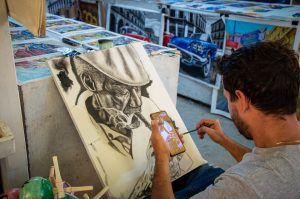Groovy designs: The iconic graphic design trends of the 1970s
The 1970s were a decade of cultural and artistic revolution. It was a time when new designs, music, and fashion were introduced, and graphic design was no exception. The graphic design trends of the 1970s were bold, colorful, and playful, and they still inspire designers today. In this article, we will explore the iconic designs that emerged during this decade.
H1: The disco era: Promoting energy, movement, and leisure
The disco era was a significant and defining moment in the 1970s. It was the period when music, dance, and fashion styles exploded, and graphic designers took note. The disco culture was all about energy, movement, and leisure, and this was reflected in the designs of the time. The use of vibrant colors, geometric shapes, and abstract patterns became the hallmark of the disco era.
H2: Psychedelic graphics: Exploring the unknown
Psychedelic graphics originated in the 1960s but continued to be popular during the 1970s. The designs were characterized by bright colors, unusual shapes, strange motifs, and optical illusion effects. The psychedelic graphics was a reflection of the cultural revolution of the time, in which people were exploring alternative lifestyles and questioning the status quo. These designs were often used in album covers, posters, and magazines related to music and popular culture.
H2: Pop Art: Celebrating consumerism and mass production
Pop Art emerged in the 1950s but continued to influence designers throughout the 1970s. The designs emphasized consumerism, mass production, and popular culture. They often featured bold typography, bright colors, and images of celebrities, products, and everyday objects. This trend was used extensively in advertising, especially for consumer products such as cars, household goods, and food.
H2: The rise of the photocopier
One of the most significant technological advances of the 1970s was the introduction of the photocopier. This machine allowed designers to create multiple copies of their work without the need for hand-drawn illustrations. It also paved the way for experimental design techniques such as photocopy art. Photocopy art involves manipulating photos or images by copying them multiple times to create ghostly and abstract effects. This technique was used in designing posters, album covers, and other forms of print media.
H1: Conclusion
The graphic design trends of the 1970s were a reflection of the cultural, social, and political changes of the time. The emergence of bold colors, unusual shapes, abstract patterns, and experimental techniques heralded a new era in design. The disco era, psychedelic graphics, pop art, and the rise of the photocopier were key landmarks in this transformative period. These trends still inspire designers today and remain an enduring legacy of the 1970s.
FAQs:
Q: What is disco culture, and how did it influence graphic design?
A: The disco culture was a music and dance movement that emerged in the 1970s. It emphasized energy, movement, and leisure. Graphic designers took note of this culture and incorporated its elements into their designs, such as the use of vibrant colors, geometric shapes, and abstract patterns.
Q: What is pop art, and how did it celebrate consumerism?
A: Pop Art is an art movement that emerged in the 1950s and celebrated consumerism, mass production, and popular culture. It often featured images of celebrities, products, and everyday objects. The bold typography, bright colors, and visual contradictions used in pop art designs were intended to raise awareness of the increasingly commercialized world.
Q: What is photocopy art, and how did it affect graphic design?
A: Photocopy art is an experimental design technique that involves manipulating photos or images by copying them multiple times to create ghostly and abstract effects. This technique was made possible by the rise of the photocopier in the 1970s. Photocopy art was used to create posters, album covers, and other forms of print media, and it opened up new possibilities for designers looking to experiment with abstract and unconventional designs.
Q: What is the significance of the geometric shapes used in 1970s graphic design?
A: Geometric shapes were popular in 1970s graphic design because they conveyed a sense of order, structure, and precision. This was particularly important in the context of an era when people were questioning traditional social structures and looking for new forms of self-expression.
Q: How did the graphic design trends of the 1970s legacy in the modern era?
A: The graphic design trends of the 1970s continue to inspire designers today. The use of vibrant colors, abstract patterns, and unconventional techniques are still prevalent in contemporary design. The legacy of the disco era, psychedelic graphics, pop art, and the rise of the photocopier has left an enduring impact on the world of graphic design.





